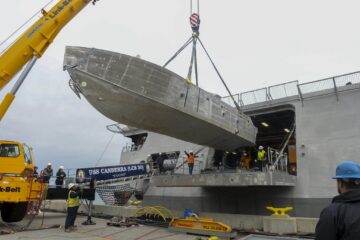From 5th Fleet Public Affairs – NAVCENT
NAVAL SUPPORT ACTIVITY, Bahrain – On Oct. 26, U.S. Naval Forces Central Command (NAVCENT) completed exercise New Horizon, the first at-sea evolution for its new unmanned task force.
During the two-day training exercise, Task Force 59 integrated and evaluated new MANTAS T-12 unmanned surface vessels (USV) that operated alongside manned U.S. patrol craft and Bahrain Defense Force maritime assets.
This marked the first time NAVCENT integrated USVs with manned assets at sea in the U.S. 5th Fleet area of operations. New Horizon was also the first time for NAVCENT’s integration of USVs with manned assets at sea alongside partner forces.
“Working with our regional partners on unmanned systems integration is crucial to enhancing collective maritime domain awareness,” said Vice Adm. Brad Cooper, commander of NAVCENT, U.S. 5th Fleet and Combined Maritime Forces. “Bahrain, as our first regional partner to collaborate with Task Force 59 during an at-sea exercise, demonstrates the strengthening of our strategic relationship.”
The first phase of New Horizon, conducted Oct. 20, featured operators controlling the USVs aboard patrol coastal ship USS Firebolt (PC 10), while the vessels conducted high-speed maneuvers in formation.
The final phase on Oct. 26 brought together a larger force of manned and unmanned maritime and aerial assets from NAVCENT, the Royal Bahrain Naval Force (RBNF) and Bahrain Coast Guard. Participating units also included patrol boat USCGC Maui (WPB 1304), an SH-60S helicopter, a V-BAT unmanned aerial vehicle and RBNF patrol craft.

Both U.S. and Bahraini forces practiced operating the vessels in formation to strengthen mutual understanding and interoperability.
“This is a significant milestone for our new task force as we accelerate the integration of unmanned systems and artificial intelligence into complex, cross-domain operations at sea,” said Capt. Michael Brasseur, commander of Task Force 59. “Real-world evaluation is essential.”
NAVCENT established the task force Sept. 9. To focus U.S. 5th Fleet efforts on unmanned systems and artificial intelligence integration.
The U.S. 5th Fleet area of operations encompasses about 2.5 million square miles of water area and includes the Arabian Gulf, Gulf of Oman, Red Sea and parts of the Indian Ocean. The expanse is comprised of 21 countries and includes three critical choke points at the Strait of Hormuz, the Suez Canal and the Strait of Bab al Mandeb at the southern tip of Yemen.
-End-
Naval News comments:
Task Force 59 was stood up just a couple months ago. With headquarters in Bahrain, it is the U.S. Navy’s first employment of unmanned aerial systems (UAS), unmanned sea vessels (USV), and unmanned underwater vehicles (UUV) in numbers that combine their capabilities with manned platforms for multidomain operations.
About MARTAC’s MANTAS T12 USV

The MANTAS family of USV is a multi-role catamaran, proficient at performing in open ocean, riverine and inland waters delivering greater mission flexibility than traditional manned systems. They are designed and produced by Maritime Tactical Systems (MARTAC) of Melbourne, Florida. Besides the U.S. Navy, one of the military user of the MANTAS is the UK MoD who last year procured three MANTAS T12 for the Royal Navy and two for the UK Strategic Command.
MANTAS T12 variant specifications
- Length: 12 ft
- Width: 3ft
- Height: 14 in
- Draft: 7 in
- Craft weight: 210 lbs
- Max payload weight: 140 lbs
- Burst speed: 40 kts
- Cruise speed: 8-20 kts
- Cruising range: 60 nm
- Ocean capable: sea state 4+
MANTAS USV key features
- Extended in-field operations with open architecture and modular design allowing for rapid adaptation and integration of sensors, advance communications and improved energy payload
- Highly reliable systems with waterproof components within the MANTAS hull
- Optional “Stealth” Mode with a positively buoyant hull to minimize detection and perform “decks awash” operations
- Performs in environments and conditions where other USV’s are unable due to MANTAS’ high-performance envelope.
MANTAS USV typical missions







